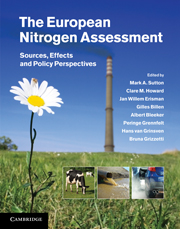Book contents
- Frontmatter
- Contents
- List of contributors
- Foreword
- Summary for policy makers
- Technical summary
- 1 Assessing our nitrogen inheritance
- Part I Nitrogen in Europe: the present position
- Part II Nitrogen processing in the biosphere
- Part III Nitrogen flows and fate at multiple spatial scales
- Part IV Managing nitrogen in relation to key societal threats
- Part V European nitrogen policies and future challenges
- 22 Costs and benefits of nitrogen in the environment
- 23 Developing integrated approaches to nitrogen management
- 24 Future scenarios of nitrogen in Europe
- 25 Coordinating European nitrogen policies between international conventions and intergovernmental organizations
- 26 Societal choice and communicating the European nitrogen challenge
- Glossary
- Index
- References
25 - Coordinating European nitrogen policies between international conventions and intergovernmental organizations
from Part V - European nitrogen policies and future challenges
Published online by Cambridge University Press: 16 May 2011
- Frontmatter
- Contents
- List of contributors
- Foreword
- Summary for policy makers
- Technical summary
- 1 Assessing our nitrogen inheritance
- Part I Nitrogen in Europe: the present position
- Part II Nitrogen processing in the biosphere
- Part III Nitrogen flows and fate at multiple spatial scales
- Part IV Managing nitrogen in relation to key societal threats
- Part V European nitrogen policies and future challenges
- 22 Costs and benefits of nitrogen in the environment
- 23 Developing integrated approaches to nitrogen management
- 24 Future scenarios of nitrogen in Europe
- 25 Coordinating European nitrogen policies between international conventions and intergovernmental organizations
- 26 Societal choice and communicating the European nitrogen challenge
- Glossary
- Index
- References
Summary
Executive summary
Nature of the problem
International treaties, such as multilateral environmental agreements (MEAs), have sought to protect the environment by intergovernmental action on many issues.
The MEAs and intergovernmental organizations (IGOs) have, between them, targeted most known environmental problems, but none has tackled nitrogen management holistically since the nitrogen issue is much broader than any of the individual interests.
Even so, several conventions have taken action to develop nitrogen policies in their specific areas of interest, but they are often limited in their options to increase their scope of action beyond their agreed mandates and may be reluctant to coordinate action with those of others.
As a result, there remains a need to develop an integrated, holistic approach for nitrogen management; an international treaty targeted explicitly on nitrogen would have the potential to bring the different elements of the nitrogen problem together.
Approaches
Some coordination between MEAs and IGOs already occurs with regard to different nitrogen threats, but the focus is inevitably on areas of overlapping interests. This chapter explores the potential for available mechanisms to be applied further across these institutions to harmonize work and to promote effective coordination on nitrogen-related threats and abatement options.
- Type
- Chapter
- Information
- The European Nitrogen AssessmentSources, Effects and Policy Perspectives, pp. 570 - 584Publisher: Cambridge University PressPrint publication year: 2011
References
- 2
- Cited by



